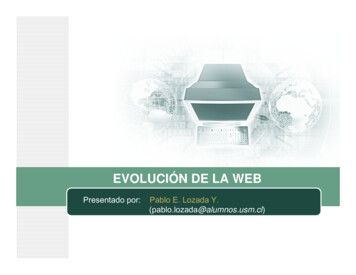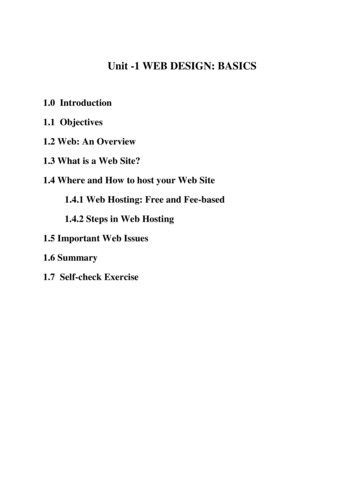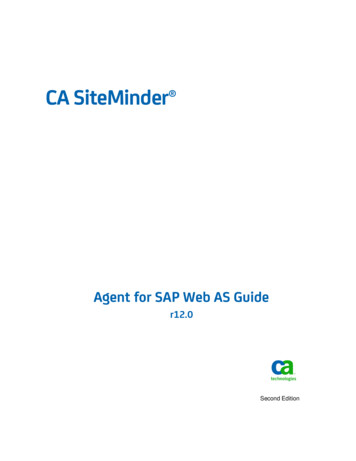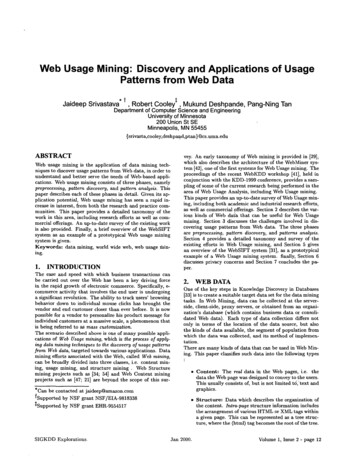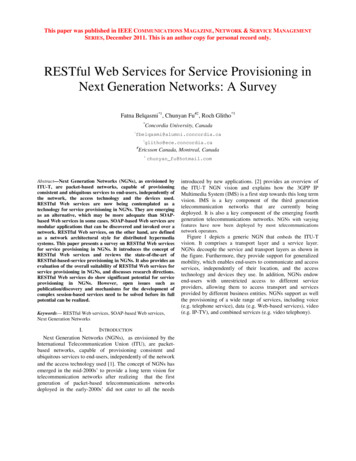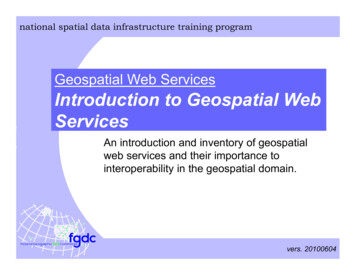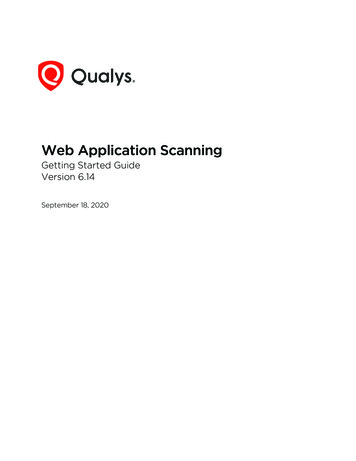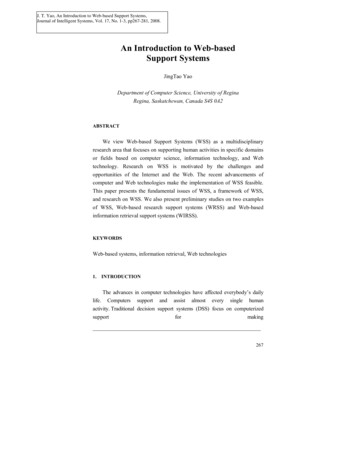
Transcription
J. T. Yao, An Introduction to Web-based Support Systems,Journal of Intelligent Systems, Vol. 17, No. 1-3, pp267-281, 2008.An Introduction to Web-basedSupport SystemsJingTao YaoDepartment of Computer Science, University of ReginaRegina, Saskatchewan, Canada S4S 0A2ABSTRACTWe view Web-based Support Systems (WSS) as a multidisciplinaryresearch area that focuses on supporting human activities in specific domainsor fields based on computer science, information technology, and Webtechnology. Research on WSS is motivated by the challenges andopportunities of the Internet and the Web. The recent advancements ofcomputer and Web technologies make the implementation of WSS feasible.This paper presents the fundamental issues of WSS, a framework of WSS,and research on WSS. We also present preliminary studies on two examplesof WSS, Web-based research support systems (WRSS) and Web-basedinformation retrieval support systems (WIRSS).KEYWORDSWeb-based systems, information retrieval, Web technologies1.INTRODUCTIONThe advances in computer technologies have affected everybody’s dailylife. Computers support and assist almost every single humanactivity. Traditional decision support systems (DSS) focus on computerizedsupportformaking267
Correspondence to: e-mail: jtyao@cs.uregina.cadecisions with respect to managerial problems (Turban 2005). Other goodexamples are computer aided software engineering (CASE) and computeraided design (CAD). With the introduction of Web technology, one mayreconsider the existing methods and re-design or modify existing systems tomeet new challenges. The Web is used both as a universal interface and asthe underlying infrastructure for Intelligent Web Information Systems (Yaoet al. 2001). There is an emerging and fast growing interest in computerizedsupport systems in many other domains such as information retrieval supportsystems (Yao & Yao 2003, Yao 2002), research support systems (Yao 2003),teaching and learning support systems (Fan 2003), computerized medicalsupport systems (Stalidis et al. 2001), knowledge management supportsystems (Ginsburg & Kambil 1999), and many more. The recentdevelopment of the Web generates further momentum to the design andimplementation of support systems (Yao 2005).Many types of Web-based Support System (WSS) have been studiedrecently by researchers (Yao & Lingras 2003, Yao et al. 2004, Yao & Yao2003b). It is argued that the time to treat Web-based support systems as anew and separate sub-area of Web intelligence is coming based on the observations of existing studies (Yao & Yao 2003b). Recently, two workshopsaimed to exchange research on the topics of WSS were held in Halifax,Canada and Beijing, China in 2003 and 2004 respectively. Many paperspublished in the proceedings and other venues cover a variety of Web-basedsupport systems, including decision support (Li & Ruhe 2003, Lu et al. 2003,Power et al. 2002, Wang 2004), research support (Keselj 2004, Tan et al.2004, Xiang et al. 2003, Xu et al. 2003, Yao 2004), retrieval support (Curra& Higgins 2003, Wegrzyn-Wolska 2004, Wu et al. 2004), teaching andlearning support (Cao & Greer 2004, Fan 2003, Fan 2004, Wetprasit 2003),data mining support (Xu et al. 2004), agricultural support (Hu et al. 2004),and business support systems (Bai et al. 2004).This article is a revised version of research presented at IICAI’05 (Yao2005b). Its aim is to introduce the new research area of WSS. Theorganization of this article is as follows. We first discuss the historical viewof WSS. A section that presents the framework and some design issues ofWSS follows. We present preliminary studies on two examples of WSS,268
Web-based research support systems (WRSS) and Web-based informationretrieval support systems (WIRSS) in Section 4.2.HISTORICAL VIEW OF WEB-BASED SUPPORT SYSTEMSThe WSS is a natural evolution of studies on various computerizedsupport systems. An ultimate goal of computer scientists is to build fullyautomated computer systems that have the same or even a higher level ofintelligence as human beings. It is hoped that these systems can replacehuman beings to perform various activities, either simple or complex.However, we can only study, design and develop systems that have someabilities to assist, support, and aid us for various activities due to the limitedtechnologies we have mastered. Research in artificial intelligence proves thatit is almost impossible to replace human intelligence with computer systems,at least within the foreseeable future (Rich & Knight 1991). With thisrestriction, we have to lower our expectation to implement systems that canfulfill more practical goals. We classify computer systems that supporthuman activities as computerized support systems (Yao & Yao 2003b).The study of computerized support systems involves many disciplines ofresearch. The most popular and successful example is DSS. Turban et al.(2005) summarize DSS as “computer-based information systems thatcombine models and data in an attempt to solve non-structured problemswith extensive user involvement through a friendly user interface” afterdiscussing various definitions. DSS can be viewed as a hybrid product of twodomains of studies. It is an approach or methodology for supporting decisionmaking. It uses interactive, flexible, adaptable computer-based informationsystems specifically developed for supporting the solution to a specific nonstructured management problem (Turban et al. 2005). DSS are derived frommanagement science and computer science. The same principle applies toother types of support systems. For instance, a medical support system or amedical expert system is the product of the marriage between medicalscience and computer science. Research support systems are the combinationof research methodology and computer science. In general, a specific supportsystem aims to support activities and operations of the specific domain.269
ig. 1: Web-based Support Systems: A multidisciplinary research2.1 Web-based Support Systems: Moving to a Standard Web PlatformThe World Wide Web provides a new medium for storing, presenting,gathering, sharing, processing, and using information. The impacts of theWeb can be felt in most aspects of our life. The impacts are twofold: Webtechnology provides us with more opportunities in terms of informationavailability, accessibility, and flexibility. However, more challenges are infront of us. We have to find the right information and tools from largelyavailable resources. We have to learn to use the existing tools that keepchanging all the time.The study of WSS aims to take the opportunities of the Web, to meet thechallenges of the Web, and to extend the human physical limitations ofinformation processing. We define WSS as a multidisciplinary research field(as depicted in Figure 1) that focuses on supporting human activities inspecific domains based on computer science, information technology, andWeb technology. One of the goals is to find out how applications andadaptations of existing methodologies on Web platforms benefit our decisionmaking and other various activities. The following are some potentialbenefits of Web technology, The Web provides a distributed infrastructure for informationprocessing. 270The Web delivers timely, secure information and tools with a userfriendly interface.The Web has no time or geographic restrictions. Users can access systemsat any time and any place.
Users can control and retrieve results remotely and instantly.TABLE 1A Two dimensional view of WSSTechnologyApplication domainComputer technologyWeb technologyDecision makingDSSWDSSBusiness applicationBSSWBSSInformation retrievalIRSSWIRSSScientific researchRSSWRSSTeachingTSSWTSSMedical applicationMSSWMSSKnowledge managementKMSSWKMSSData miningDMSSWDMSS 2.2 A Two Dimensional View of WSSWeb-based Support Systems have two important features that can beunderstood as extensions of existing research in two dimensions, as shown inTable 1. In the application dimension, A WSS covers support systems indifferent domains. They can be viewed as natural extensions of decisionsupport systems. In the technology dimension, WSS uses the Web as a newplatform for the delivery of support. Along the application dimension, thelessons and experiences from DSS can be applied to other domains. Alongthe technology dimension, new advances in technology can lead to furtherinnovations in support systems. The two-dimensional view of WSS providesa simple classification. Schematically, suppose A is a specific domain, acomputerized support system for the domain can be termed as an A support271
system. The use of the Web results in Web-based A support systems.TABLE 2Summary of the Google search results on WSSSearch PhrasesDecision support systemDecision support systemsWeb-based decision support systemWeb-based decision support systemsWeb-based decision supportBusiness support systemBusiness support systemsWeb-based business support systemWeb-based business support systemsWeb-based business supportNegotiation support systemNegotiation support systemsWeb-based negotiation support systemWeb-based negotiation support systemsWeb-based negotiation supportInformation retrieval support systemInformation retrieval support systemsWeb-based information retrieval support systemWeb-based information retrieval support systemsWeb-based information retrieval supportResearch support systemResearch support systemsWeb-based research support systemWeb-based research support systemsWeb-based research supportTeaching support systemTeaching support systemsWeb-based teaching support systemWeb-based teaching support systemsWeb-based teaching supportMedical support systemMedical support systemsWeb-based medical support systemWeb-based medical support systemsWeb-based medical supportKnowledge management support systemKnowledge management support systemsWeb-based knowledge management support systemWeb-based knowledge management support systemsWeb-based knowledge management supportData mining support systemData mining support systemsWeb-based data mining support system272Number of 9349382453319100160220825122
Web-based data mining support systemsWeb-based data mining support002222Based on such a scheme, we used one of the most popular search engines,Google (http://www.google.com), to find evidence of various existing supportsystems. Table 2 shows search results obtained in August of 2003, 2004, and2005. The first column Search Phrases is the phrase we used of links returnedby Google with the search phrase. The results suggest that users haveconducted numerous research tasks regarding various support systems.Decision support system(s), business support system(s), negotiation supportsystem(s), and medical support system(s) are amongst the highest returned hits.An interesting observation from Table 2 is that the majority of support systemswith high hit rates are business and management oriented. Technical orientedsupport systems had not been paid attention to by researchers. Therefore, weshould investigate more on the technical oriented support systems such assupport for data mining, research, and learning.Although the advantages of applying Web technology to support systemsare sufficient, researchers have not paid enough attention to the concept ofWeb-based support systems. It is clear to see from the search results in Table 2that the number of hits for each type of Web-based support systems isdramatically lower than its computerized support system counterpart. Forinstance, the hits of “Medical support system” and “Medical support systems”are around 1,000. However, there were none when we changed the phrase to“Web-based medical support system” or “Web-based medical support systems”in 2003. By comparing the number of hits from 2003 to 2005 respectively, onecan observe that there is a growing interest in Web-based support systems. Dueto the coverage of Google databases, the search results may not always beconsistent. However, the general trend is shown as increasing.3.THE ARCHITECTURE OF WEB-BASED SUPPORT SYSTEMSInterface, functionality, and databases are some of the components thatare needed to be considered when we design a system. The architecture ofWSS can be viewed as a (thin) client/server structure as shown in Figure 2.The users, including decision makers and information seekers, are clients onthe top layer. They access the system with browsers via the Web and273
Internet. The interface that is designed on the server side will be presented onFig. 2:An architecture of Web-based support systemsthe274
client’s side by browsers. The lower layers and components encapsulated bythe oval dotted line are very similar to conventional computerized supportsystems. In other words, a Web-based support system can be viewed as asupport system with the Web and Internet as the interface.The architecture shown in Figure 2 is presented from a usage point of viewand is logical but not physical. In practice, data and control components maynot necessarily sit physically on the same point of the network, which is one ofthe major differences between WSS and traditional computerized supportsystems. System components may be spread all over the network. Users of thesystems are located globally. Agent, grid computing, and Web services playimportant roles in WSS implementation.The data layer comprises two components. A database is a basiccomponent in any modern system. WSS is not an exception. Another majorcomponent is the knowledge base. The knowledge base stores rules, principles,and guidelines used in supporting activities. We intend to divide the knowledgebase into two parts: a domain-specific knowledge base and a domainindependent knowledge base. The former is the knowledge specific to thedomain that is supported. The latter involves general knowledge for all supportsystems.Knowledge management, data management, information retrieval, datamining, and other control facilities form the management layer. These serveas middleware for the three-tier client/server architecture and as theintermediaries between the interface and data layers. Reasoning, inference,and agent technologies play important roles on this layer. The separationbetween the management of data and user profiles results in a secure andstandardized system. To take advantage of Web technology, these processesare distributed over the Internet to form a virtual server. In fact, databasesand knowledge bases on the lower tier are also distributed.The WSS can be classified into three levels. The first level is support forpersonal activities. An example of such support is research support for individuals (Yao 2003). Personal research activities such as search, retrieval,reading, and writing are supported. The second level is organizational support,such as research support on an institutional level (Tang et al. 2003). The toplevel is the network level. The collaborations between organizations or decision275
making by a group of people like in group decision support systems fall in thislevel. The group-decision support room may be a virtual room on the Web.4.WSS EXAMPLES4.1 Web-based Research Support SystemsAs new technologies evolve and existing technologies expand, scientistsmust adjust accordingly and make full use of these emerging tools whencarrying out research. Scientists face many challenges in using Web-basedinformation resources, such as information overload, misinformation, fees,poorly designed navigation, retrieval, and browsing tools; effectively,supporting scientists to meet such challenges is an important issue. Manycomputerized systems have been implemented to support various researchactivities. The study of Web-based Research Support Systems (WRSS) istrying to provide a common framework for such systems (Yao 2003). Similarto what we discussed above, WRSS is also interdisciplinary, involving atleast three domain of studies: research methodologies (purpose of research,research methods, research activities), computer science (computer systemsthat support various research activities), and the Web (as an infrastructureand a medium of support delivery as well as a common user interface).Many computerized systems, although not designed specifically forresearch support, have been used by scientists in different stages of research.The WRSS aim at pooling together all these isolated efforts and unintegrated systems with a common goal of research support. Researchactivities can be broadly classified into two levels—the institutional level andthe individual level. The institutional level deals with the management ofresearch and research projects in an institution. The individual level is theactual research process of a scientist. A research process model at theindividual level may include the following phases: idea generating, problemdefinition, procedure design and planning, observation and experimentation,data analysis, results interpretation and explanation, and communication anddissemination (Yao 2003). It is possible to combine several phases into onephase or to divide one phase into more detailed steps. The division betweenphases is not clear cut. Moreover, the research process does not follow arigid sequencing of the phases. Iteration of different phrases may benecessary.276
To support a large spectrum of research activities, the WRSS must beflexible and have much functionality (Yao 2003). We summarize some basicfunctionality in this section.The first component is profile management, which deals with profiles ofusers of WRSS, i.e., scientists. Different classes of profiles may exist, suchas research interest, personal libraries, address books, Web bookmarks, andmany more. The profile management module collects, organizes, and storesall relevant information for a scientist. Resource management is the secondfunctionality of WRSS. Many types of resources exist for supporting research,such as human resources, tool resources, and information/knowledge resources.Database, knowledge base, information retrieval, and agent technologies canbe used. Web search engines can be used for retrieval. The third componentis data/knowledge management. Typically, research involves the collectionand processing of a large amount of data. The WRSS must have a module torecord the useful data, which gathers information and knowledge during theentire research process. The module must contain some data/knowledgeoperations and retrieval facilities.The profile, resource, and data management components form a solidbasis of WRSS. A research support system consists of many sub-systems tosupport different activities. They share common data and knowledge bases.We list some specific supporting functionality: exploring support, retrievalsupport, reading support, analyzing support, and writing support. As a specifictype of WSS, the WRSS assist scientists to improve their research qualityand productivity. The feasibility of such systems is based on the assumptionthat relatively systematic approach exists in scientific research. Furthermore,a general research process can be established, consisting of several steps orphases, such as idea generation, exploration, problem definition, proceduredesign and planning, observation and experimentation, data analysis, resultsinterpretation, and communication. A number of activities are involved ineach of these phases.4.2 Web-based Information Retrieval Support SystemsEach support sub-system of WRSS has its special feature, as describedabove. Information retrieval support is the one that has been paid attention by277
some researchers (Yao & Yao 2003, Yao 2002). Web-based Informationretrieval support systems (WIRSS) are designed with the objective to providethe necessary utilities, tools, and languages that support a user to performvarious tasks in finding useful information and knowledge. We summarizethe WIRSS in this section.Information retrieval support systems, Web browsers, and Web searchengines extend the basic search functionalities of data retrieval systemsexemplified by a database system. They provide basic functionalities to assist auser or scientist in the context of libraries and in the early stage of the Web. Ascientist may have to perform many different tasks when finding usefulinformation. The new tasks include understanding, analysis, organization, anddiscovery in addition to the conventional tasks of searching and browsing. It isdiscussed in literature that WIRSS is actually a natural evolution from retrievalsystems. The evolution from data retrieval systems to information retrievalsystems and from information retrieval systems to information retrieval supportsystems have been discussed in detail (Yao 2002). The WIRSS attempt toresolve the problems of information retrieval systems by providing moresupporting functionalities. A WIRSS provides models, languages, utilities, andtools to assist a user in investigating, analyzing, understanding, and organizinga document collection and search results. These tools allow the user to exploreboth semantic and structural information of each individual document, as wellas the entire collection.We can classify WIRSS models into three related types. Documents in adocument collection serve as the raw data of WIRSS. The document modelsdeal with representations and interpretations of documents and the documentcollection. They allow multiple representations of documents. Granularcomputing plays an important role in the construction of document models. Theretrieval model deals with the search functionality. They provide languages andtools to assist a user in performing tasks such as searching and browsing.WIRSS should provide multi-strategy retrieval. A user can choose differentretrieval models with respect to different document models. The presentationmodels deal with the representation and interpretations of results from thesearch. They allow a user to view and arrange search results as well as variousdocument models. The same results can be viewed in different ways by usingdistinct presentation models. Moreover, a user can analyze and compare results278
from different retrieval models. A single document model, a retrieval model, orpresentation model may not be suitable for different types of users. Therefore,the WIRSS must support multiple models as well as provide tools for users tomanage various models.A WIRSS focuses on the supporting functionalities of informationretrieval. Yet, existing information retrieval systems focus only on the searchand browsing functionalities. The WIRSS are more flexible and combine thefunctionalities of IRS, Web browser, and Web search engines. It is expectedthat current IRS should be extended to support more user tasks. A WIRSS isbased on a different design philosophy that emphasizes the supportingfunctionality of the system instead of the specific search and browsingfunctionality. In the process of finding useful information, a user plays anactive role in a WIRSS by using the utilities, tools, and languages provided bythe system. The components of a WIRSS also include data management, modelmanagement, knowledge-based management, and user interface subsystems.5.CONCLUDING REMARKSThe emerging interdisciplinary study of Web-based support systems ismotivated by the challenges and opportunities of the Web. It focuses on thetheories, technologies, and tools for the design and implementation of Webbased systems that support various human activities. The research of Webbased support systems is a natural evolution and extension of existing research.The evolution of the application dimension is the extension of decision supportsystems to computerized support systems. With the emergence of Web technology and Web intelligence, various Web-based support systems are extendedfrom a single machine—a single user computerized support system. Theresearch on Web-based support systems can be classified into a few categories.There are four types of existing research, namely, WSS for specific domains,Web-based applications, techniques that are related to WSS and design, and thedevelopment of WSS that can be classified as WSS research.279
REFERENCESBai, J., Paradis, F. and Nie, J.Y. 2004. Web-supported matching andclassification of business, in WSS’04, 28-36.Cao, Y. and Greer, J. 2004. Facilitating Web-based education using intelligent agent technologies, in WSS’04, 37-44.Curra, K. and Higgins, L. 2003. A Web-based intelligent case-based reasoninglegal aid retrieval information system, in WSS’03, 63-7.Fan, L. 2004. Adaptation and personalization in Web-based learning supportsystems, in WSS’04, 60-6.Fan, L. and Yao, Y.Y. 2003. Web-based learning support systems, in WSS’03,43-8.Ginsburg, M. and Kambil, A. 1999. Annotate: A Web-based knowledgemanagement support system for document collections, in Proceedings ofHICSS-32.Hu, Y.G., Zhi Quan, Z. and Yao, Y.Y. 2004. Web-based agricultural supportsystems, in WSS’04, 75-80.Keselj, V. and Cercone, N. 2004. PPDN—a Framework for Peer-to-PeerCollaborative Research Network, in WSS’04, 88-93.Li, J. and Ruhe, G. 2003. Web-based decision support for software releaseplanning, in WSS’03, 13-20.Lu, J., Zhang, G. and Shi, C. 2003. Framework and implementation of aWeb-based multi-objective decision support system: WMODSS, inWSS’03, 7-11.Power, D.J. and Kaparthi, S. 2002. Building Web-based decision supportsystems, Studies in Informatics and Control, 11, 291-302.Rich, E. and Knight, K. 1991. Artificial intelligence, McGraw-Hill.Stalidis, G., Prentza, A., Vlachos, I.N., Maglavera, S. and Koutsouris, D.2001. Medical support system for continuation of care based on XMLWeb technology, International Journal of Medical Informatics, 64, 385400.Tang, H., Wu, Y., Yao, J.T., Wang, G.Y. and Yao, Y.Y. 2003. CUPTRSS: aWeb-based research support system, in WSS’03, 21-8.Turban, E., Aronson, J.E., and Liang, T.P. 2005. Decision support systemsand intelligent systems, New Jersey, USA, Pearson Education.Wang, M. Design of merchant reputation system: a Web-based purchasedecision support system, in WSS’04, 149-54, 2004.Wetprasit, R. 2003. Developing an intelligent Web-based Thai tutor: someissues in the temporal expert, in WSS’03, 49-53.Wegrzyn-Wolska, K. 2004. FIM-metaindexer: a meta-search engine purposebuilt for the French civil service and statistical classification of theinterrogated search engines, in WSS’04, 163-70.280
Wu, Z.M., Mundluru, D. and Raghavan, V.V. 2004. Automatically detectingBoolean operations supported by search engines, towards search enginequery language discovery, in WSS’04, 171-78.Xiang, X., Huang, Y. and Madey, G. 2003. A Web-based collaboratory forsupporting environmental science research, in WSS’03, 29-36.Xu, J., Huang, Y. and Madey, G. 2003. A research support systems framework for Web data mining, in WSS’03, 37-41.Yao, J.T. 2005. Design of Web-based support systems, in Proceedings of the8th International Conference on Computer Science and Informatics(CSI), 349-52.Yao, J.T. 2005b. On Web-based support systems, Proceedings of the 2ndIndian International Conference on Artificial Intelligence, Edited byPrasad, B, IICAI, 2589-600.Yao, J.T. and Lingras, P. 2003. Proceedings of 2003 WI/IAT Workshop onApplications, Products and Services of Web-based Support System(WSS’03), Saint Mary's University, Canada.Yao, J.T., Raghvan, V.V. and Wang, G.Y. 2004. Proceedings of the SecondInternational Workshop on Web-based Support System (WSS’04), SaintMary's University, Canada.Yao, J.T. and Yao, Y.Y. 2003. Web-based information retrieval supportsystems: building research tools for scientists in the new informationage, Proceedings of the IEEE/WIC International Conference on WebIntelligence, 570-73.Yao, J.T. and Yao, Y.Y. 2003b. Web-based support systems, in WSS’03, 1-5,2003.Yao, Y.Y. 2002. Information retrieval support systems, Proceedings ofFUZZ-IEEE'02, 773-78.Yao, Y.Y. 2003. A framework for Web-based research support systems, inProceedings of COMPSAC'03, 601-6.Yao, Y.Y. 2004. Web-based research support systems, in WSS’04, 1-6.Yao, Y.Y., Zhong, N., Liu, J. and Ohsuga, S. 2001. Web intelligence (WI):research challenges and trends in the new information age, in WebIntelligence: Research and Development, LNAI 2198, Berlin, Germany,Springer, 1-17.281
the technology dimension, new advances in technology can lead to further innovations in support systems. The two-dimensional view of WSS provides a simple classification. Schematically, suppose . A. . Web-based information retrieval support systems 33 80 172 Web-based information retrieval support 33 82 179 Research support system 750 743 718

